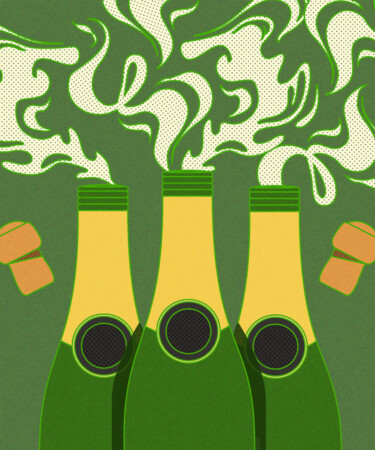New Year’s Eve is upon us and nothing screams celebration quite like a bottle of Champagne. Whether you’re toasting to 2024’s end or cheers-ing to the start of 2025, countless bottles of bubbly are sure to be popped as the clock strikes midnight. But if you’re storing your bottles in the fridge and pulling them out just before serving, you may notice a large cloud of vapor emerge as the cork pops out.
Nicknamed “Champagne smoke,” this vapor cloud isn’t anything to worry about and will typically dissolve within seconds, but can still be a little surprising if you aren’t prepared for it.
To learn more about Champagne smoke and how it forms, VinePair tapped Cameron Philip, a sommelier at NYC hotspot Coqodaq, home of the largest Champagne collection in the United States.
“When you open up a bottle of Champagne, there is so much pressure involved that it’s actually freezing water vapor in the process and creating that small frozen cloud for a moment,” Philip explains. “I mean, a Champagne cork has the same amount of pressure as the tire of an 18-wheeler. So all that pressure is released and creates this gas that freezes mid-air before it blows off.”
Temperature also has a great deal to do with how much “smoke” will emerge when you hear that satisfying pop. If your bottle has been sitting out on the counter for hours, you’re unlikely to see much of a vapor cloud after your cork. Instead, the wine itself will probably end up exploding out of the bottle as carbon dioxide is much less stable at warmer temperatures. Conversely, if your sparkling wine has been pulled right from the fridge after hours of chilling, you’ll likely see a fairly sizable cloud.
“The colder you get a bottle, the more stable the effervescence is on the inside, meaning the wine will be less aggressive when launching out of the bottle,” Philip says. “However, the colder the bottle, the colder the vapor is as well. So you have a very chilled liquid paired with an intense pressure change forcing that cloud to appear.”
While the cloud is entirely harmless and not a reflection of the wine’s quality, Philip advises waiting until it has fully evaporated before pouring the bubbly and giving it a smell, lest you inhale straight CO2. But if you’re in a rush, there are some ways to minimize the amount of vapor that emerges, and it’s all about how the bottle is opened.
Philip explains that Champagne — or any other sparkling wine for that matter — should always be opened at a 45-degree angle, with the cork tilted away from the body. From there, they explain, the cage should be loosened but not removed and held in place along with the cork with your non-dominant hand. Then, the bottle — not the cork — should be grabbed from the bottom with your dominant hand and twisted from there, slowly and very gently.
“You should never open a bottle by twisting the cork,” Philip says. “By using this technique, you’re sort of gently working the cork out, which slowly lets a little bit of air seep in and will eventually pop the cork without making that huge explosive sound. It also reduces the amount of smoke that emerges.”
*Image retrieved from Irina via stock.adobe.com
